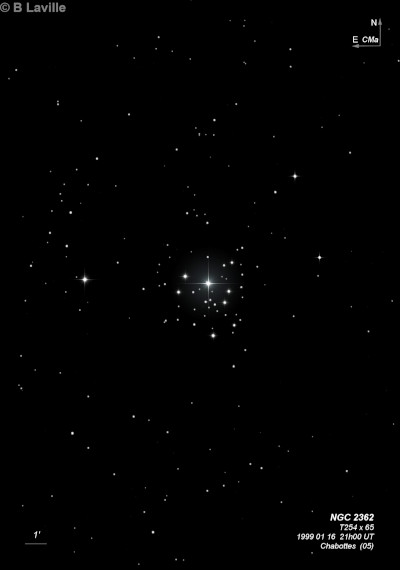
Giovanni Hodierna probably discovered NGC 2362 = H VII-17 = h441 = h3077 around 1654 (marked on a map of Canis Major). It was discovered again by William Herschel on 4 Mar 1783 before starting his sweeps, with his 6.2-inch reflector. He found it again on 6 Mar 1785 (sweep 381) and described it as "a most beautiful cluster of pretty large stars with one of the 7th magnitude in the center, which however I suppose does not belong to it." John Herschel observed the cluster from both Slough and the Cape of Good Hope, where he recorded "a fine cluster of discrete stars, 60 or 70 in number. R, gbM, 8' diameter." It's surprising this bright cluster wasn't found by one of Messier's contemporaries.
300/350mm - 13.1" (1/30/06 - Costa Rica): gorgeous low power field surrounding Tau CMa using the 20 Nagler (75x). Tau was easily resolved into a triple with two mag 10 and 11.2 companions at 8.5" and 14" to the east. At 170x, 75-80 stars are visible and the cluster appears fully resolved. A string of stars passes to the north of Tau oriented NW to SE. Several faint stars and a detached clump lie to the north of Tau beyond the string. A mag 8.5 star marks the south border of the cluster.
13.1" (2/18/04 - Costa Rica): stunning open cluster at 105x surrounding Tau Canis Majoris which is a very close triple star. Perhaps 75 stars are resolved in a well-detached 6' region.
13.1" 50 stars in a triangular-shape surrounding Tau Canis Majoris, very rich, impressive.
400/500mm - 17.5" (3/2/02): at 100x, this is a gorgeous, uniformly rich cluster surrounding Tau CMa, which is offset north of center. A WNW-ESE string of stars north of Tau gives a flattened border and the rich southern portion tapers to the south giving a triangular appearance. At 220x, ~60 stars are visible in a 6' diameter, many of 10.5-11. Just following the central star to the ESE are two mag 11 companions. Several other fainter stars are in the central core including one fairly close preceding.
17.5" (2/28/87): about 75 stars in 6' diameter surrounding Tau Canis Majoris (V = 4.4) in an unusually rich, impressive cluster! Tau is resolved into several components.
Notes by Steve Gottlieb